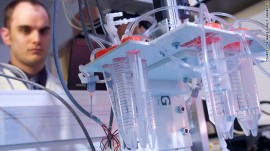
Soldiers are prone to get wounded in the battlefield. In this sense, scientists from the Wake Forest Institute for Regenerative Medicine came to develop a study called a specialized skin “printing” system as a new way of treating wounds in t5he future.
Inspired by the typical inkjet printer normally used in homes and offices, researchers of this institute which is under the US Defense Department was able to formulate this project.
According to Dr. Anthony Atala, the institute’s director, they started by placing cells instead of ink inside the ink cartridges pulled from a typical inkjet printer.
The main purpose of this device is to restore a skin that has been damaged or burned.
On the process, this project is still in its pre-clinical phase. Atala adds that this might need another five more years before it will be fully be available for use on wounded victims.
Similar studies will be conducted by other universities such as the Cornell University and the Medical University of South Carolina, Charleston.
As a support, the American (–foul word(s) removed–)ociation for the Advancement of Science Conference is held today to discuss more views regarding this project.
This is a closer look to the idea that researchers believe that using similar process will contribute not just for the skin but to the repair of other organs as well.
An approximate fund of $50 million will be given to the Wake Forest to let them finance and continue developing the skin printing project and its other on going projects at present.
An overview of the function of this skin “bio-printer” process, the initial step is to get a sample of the patient’s skin using a chemical solution. Then, these cells will be separated to replicate itself within a specialized environment where the development of cells must undergo.
Atala relates that they expand cells into large quantities enough to be put into cartridges so the printer could print it on the patient’s wounded surface.
Printer heads were specially designed making use of the pressurized nozzles but is not totally similar to the one found in the usual inkjet printers.
Fabricating healthy skin will always depend on the size and type of burn where it can be take effect from minutes to a few hours. With this, building one layer of cells to the other is easy. A new skin will be reformed as the new cells get mature.
There is a positive view regarding this project as shown in its preliminary laboratory test results.
In this wise, giving a hope of having a “healthy skin” is at hand not just intended for wounded soldiers but also sharing its benefit to civilians who wanted it.
